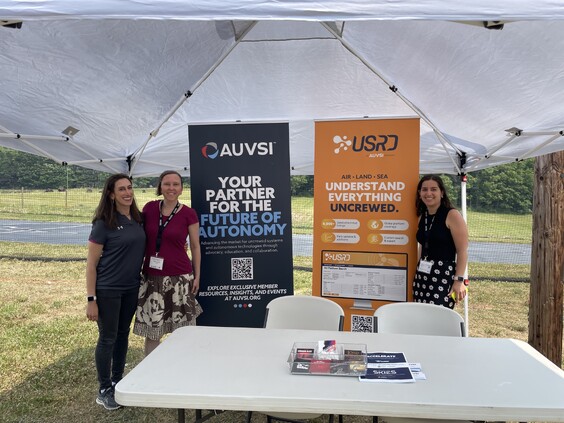The Association for Uncrewed Vehicle Systems International (AUVSI) exhibited at the Airspace Awareness and Protection Conference, co-hosted by Xelevate – the DC and NC Unmanned Aerial Systems (UAS) Centre of Excellence and Counter-UAS hub.
AUVSI HQ representatives discussed with attendees topics including the regulatory landscape, AUVSI’s leadership on the FAA’s Counter-UAS Aviation Rulemaking Committee, and the technologies and systems that will ensure the secure integration of drones into the national airspace system. The following sets out these remarks:
The big picture
Drones provide significant benefits – such as increased productivity, new business models, and enhanced infrastructure inspections, there are risks that are clearly present. A comprehensive counter-UAS strategy is necessary for the mitigation of these threats.
AUVSI has always been stewards of ensuring a safe and integrated airspace – and this is no different for counter technologies.
AUVSI Air Advocacy
AUVSI maintains advocacy committees across all our domains that direct our regulatory priorities. Our Air Advocacy Committee (AAC) sets the legislative and regulatory priorities in the air domain for the association via consensus-based input and feedback from its membership.
Our AAC member companies work intimately with federal regulators in the Executive Branch, lawmakers and their staffs in the Legislative Branch, as well as state, local, and tribal officials, to help safely and swiftly scale Advanced Air Mobility (AAM) integration in a meaningful way. AUVSI engages in advocacy at the state level across all fifty states, which includes working with 30+ chapters located across the U.S. made up of local end-users and business owners.
The AAC itself is comprised of a diverse group of member companies, including UAS operators, UAS manufacturers, software companies, defense contractors, Counter-UAS companies, AAM companies, Drone as First Responder (DFR) companies, and public safety experts.
AUVSI also has a counter-UAS subcommittee within the AAC that allows us to work with our counter specific members on what they are doing and their policy priorities.
Current Regulatory Landscape
The current federal authority for counter-UAS comes from the 2018 Preventing Emerging Threats Act, which temporarily authorized the Department of Homeland Security (DHS) and Department of Justice (DOJ) to conduct domestic detection and mitigation activities. This authority was granted on a temporary basis, so Congress must reauthorize it periodically, and is currently set to expire in September. The White House has announced a domestic CUAS National Action Plan. The plan provides for eight recommendations for action:
- Work with congress to enact legislation expanding the actors with CUAS authorities
- Establish a list of US gov authorized detection equipment
- Establish oversight and enablement mechanisms to support critical infrastructure owners and operators
- Establish a national CUAS training center
- Create a federal UAS incident tracking database
- Establish a mechanism for research, development, testing, and evaluation on UAS detection and mitigation technology
- Enact, with congress, criminal statutes for legal and illegal uses
- Enhance cooperation with the international community on CUAS tech
Last month, Senators Peters, Johnson, Sinema, and Hoeven reintroduced the “Safeguarding the Homeland from the Threats Posted by Unmanned Aircraft Systems Act” to:
- Reauthorize DHS and DOJ’s current CUAS authorities, and authorizes the TSA to protect transportation infrastructure from drone threats
- Allow state and local law enforcement and critical infrastructure owners and operators use drone detection tech approved by DHS
- Create a pilot program for state, local, and tribal law enforcement to mitigate UAS threats
- Require DHS to develop a database of security related UAS incidents
AUVSI’s Positions
AUVSI is committed to working to ensure the security of our national airspace, and an aspect of that is making supporting Counter-UAS authorities. AUVSI unequivocally supports the reauthorization of the authority that is given to DHS and DOJ in the Preventing Emerging Threats Act. It is imperative that we ensure these agencies continue to have the authority necessary to do the work in the CUAS space.
We are further supportive of TSA having the ability to keep nefarious drones away from airports. It is a problem for everyone when a bad actor causes problems at an airport. As we have seen with past incidents that gain international attention, public perception is critical to the success of the industry, and we can’t allow a few bad actors to derail our industry’s important work.
UAS detection and mitigation technologies are necessary, and they must be done in a way that does not interfere with the current safety of the NAS – a goal that AUVSI is actively working toward.
FAA Aviation Rulemaking Committee (ARC)
AUVSI’s Chief Advocacy Officer, Michael Robbins, is serving as a co-chair on the FAA’s UAS Detection and Mitigation Systems ARC as a forefront expert in the c-UAS space. In this role, he is able to represent the needs of our industry and opinions of our members in a way that will shape policy recommendations.
The ARC was established by the FAA in March 2023 and began meeting in May, and is made up of members from the crewed and uncrewed aviation communities and members from the FAA. The ARC is tasked with providing recommendations to the FAA for a plan for certification, permitting, authorizing, or allowing of the deployment of technologies or systems for the detection and mitigation of UAS, without causing adverse impact to the NAS. This purpose is largely to chart a path for the FAA to safely integrate detection and mitigation technology into NAS.
For more information visit:
www.auvsi.org




